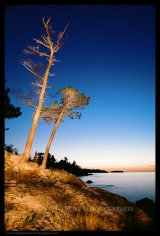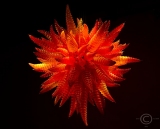- Forum
- Photography and Camera Forum
- Photo Galleries - For General Display or Critique
- Film Photography
- Who pulls and pushes there film
Who pulls and pushes there film
-
 Topic Author
Topic Author
- Arkangel7x3
- The Lounger
-
- Nikon D300
- Followers: 45
- Posts: 1374
-
Points:
390
Post #209091
"If it's to good to be true best to shoot it again"
-

- Rob pix4u2
- Photo Guru
- Nikon N90s & FE film & D90 and D90 digital bodies
- Followers: 196
- Posts: 4204
-
Points:
30
Post #209095
Remember to engage brain before putting mouth in gear
Rob Huelsman Sr.
My Facebook www.facebook.com/ImaginACTIONPhotography
Post #209114
Are you doing B&W darkroom work? I'm just wondering if the reason your professor is having you do that is to give you more range of tones in your negatives to work with in the darkroom. I've sometimes bracketed shots to get lighter or darker negatives to make sure I had one to get a nice print from.
Ask your professor... maybe it's something to do with getting more gray tones, I'd be interested to know what the course is and what you're working on. I love shooting B&W film.
Sharon
-
 Topic Author
Topic Author
- Arkangel7x3
- The Lounger
-
- Nikon D300
- Followers: 45
- Posts: 1374
-
Points:
390
Post #209116
icepics wrote: I've had film pushed/pulled but not in a long time, although I shoot film. It seems like I didn't find it made that much difference or didn't like the results all that much to bother with it.
Are you doing B&W darkroom work? I'm just wondering if the reason your professor is having you do that is to give you more range of tones in your negatives to work with in the darkroom. I've sometimes bracketed shots to get lighter or darker negatives to make sure I had one to get a nice print from.
Ask your professor... maybe it's something to do with getting more gray tones, I'd be interested to know what the course is and what you're working on. I love shooting B&W film.
Yes its darkroom work and yes that was his reasoning to get the two more grey tones vs default 9
"If it's to good to be true best to shoot it again"
-

- Henry Peach
- Apprentice
-
- I currently use a 5DII or Sony Nex-3 most of the time.
- Followers: 50
- Posts: 2925
-
Points:
16
Post #209606
The numbers on the film box/cassette are merely suggestions. Personal film testing is required to determine a personal ISO. Many things can influence this so it may not be very accurate to use someone else's results. Even when using the same gear and film different photographers can get different optimal film speed results.
It is a very common practice to rate negative films one stop slower (over expose) than what it says on the box. This helps insure good shadow detail. With negative film the big concern is the shadows. Overexposed highlights can be burned in. Underexposed shadows are blank film, and there is no detail to be recovered. This is why the advice with neg film is to expose for the shadows and print for the highlights. The opposite is true with positive films: they are usually underexposed, and the issue with blank film is on the highlight end of the tonal range.
The main reason I would adjust exposure and processing isn't to capture more tones, but rather to create an easy to print negative. Prints can only display about 5 stops of full detail. That's less than the film is capable of recording. I would start by testing my film choice to determine my normal personal film speed and normal development time (normal dev time is referred to as "n"). Google "personal film speed testing" for lots of articles on how to do this.
Out in the real world I measure the difference in stops between my shadows where I wanted full detail and my highlights where I wanted full detail. If the difference is 5 stops then I expose and develop normally (my normal, not necessarily what Kodak or my buddy recommends). If the difference is more than 5 stops I would over expose and decrease development time. This compresses the tonal range and decreases contrast. For instance for 6 stops I would rate the film at a stop slower (over expose) than my normal film speed, and then decrease development by 1 stop or n-1. How much time is a stop's worth is determined in personal testing. For 7 stops I would over expose 2 stops and develop n-2. If there is less than 5 stops between important shadows and highlights then I would under expose and over develop in a similar manner: 4 stops = -1 exp & n+1, 3 stops = -2 exp & n+2. The goal here is to expand the tonal range.
Obviously this technique doesn't work well with roll film unless all the shots on the roll are made in the same sort of lighting. For shooting 35mm film I would roll my own 10-12 exposure rolls. One way to get around this if you are using longer rolls is to switch to a 2 bath compensating developer instead of single bath developer. Single bath developer contains both developer and activator. Compensating developer keeps them separate. First you soak the film in the developer. Then the developer is dumped out, and only the developer that has soaked into the emulsion remains. The activator is poured in, and begins to develop the film. Areas of the film that received more exposure (highlights) develop faster, and when the developer is deplete developing stops. While areas that had less exposure (shadows) continue to develop longer. It takes care of contrast and tonal range on its own even if the exposure rating or lighting contrast changes from shot to shot on the same roll.
Another reason for pushing is that there really isn't any film faster than ISO 800. If you read the fine print (or do personal testing) for most films rated over ISO 800 you will find it's a push to get ISO 1600 or 3200. That's what the little "p" stands for in Tmax 3200p. Kodak says it's ISO 1000 with Tmax developer, and ISO 800 with most other developers.
Henry Horenstein's books "Black and White Photography: A Basic Manual" and "Beyond Basic Photography: A Technical Manual" are excellent learning resources. They are fairly easy reading, and you should be able to find them cheap in a used bookstore or online. After you read the Horenstein books go for Ansel Adams' "The Camera", "The Negative", and "The Print".
-

- Karl Wertanen
- The Lounger
-
- Mamiya 7II Medium Format 6x7 Rangefinder Film Camera, Mamiya RZ67 Pro II Medium Format 6x7 Film Camera, and a few Minlolta Maxxum 35mm Film cameras
- Followers: 220
- Posts: 1342
-
Points:
10
Post #209666
Henry Peach wrote: Pushing and pulling is usually combined with development changes. For instance increasing development time when pushing, and decreasing development time when pulling.
The numbers on the film box/cassette are merely suggestions. Personal film testing is required to determine a personal ISO. Many things can influence this so it may not be very accurate to use someone else's results. Even when using the same gear and film different photographers can get different optimal film speed results.
It is a very common practice to rate negative films one stop slower (over expose) than what it says on the box. This helps insure good shadow detail. With negative film the big concern is the shadows. Overexposed highlights can be burned in. Underexposed shadows are blank film, and there is no detail to be recovered. This is why the advice with neg film is to expose for the shadows and print for the highlights. The opposite is true with positive films: they are usually underexposed, and the issue with blank film is on the highlight end of the tonal range.
The main reason I would adjust exposure and processing isn't to capture more tones, but rather to create an easy to print negative. Prints can only display about 5 stops of full detail. That's less than the film is capable of recording. I would start by testing my film choice to determine my normal personal film speed and normal development time (normal dev time is referred to as "n"). Google "personal film speed testing" for lots of articles on how to do this.
Out in the real world I measure the difference in stops between my shadows where I wanted full detail and my highlights where I wanted full detail. If the difference is 5 stops then I expose and develop normally (my normal, not necessarily what Kodak or my buddy recommends). If the difference is more than 5 stops I would over expose and decrease development time. This compresses the tonal range and decreases contrast. For instance for 6 stops I would rate the film at a stop slower (over expose) than my normal film speed, and then decrease development by 1 stop or n-1. How much time is a stop's worth is determined in personal testing. For 7 stops I would over expose 2 stops and develop n-2. If there is less than 5 stops between important shadows and highlights then I would under expose and over develop in a similar manner: 4 stops = -1 exp & n+1, 3 stops = -2 exp & n+2. The goal here is to expand the tonal range.
Obviously this technique doesn't work well with roll film unless all the shots on the roll are made in the same sort of lighting. For shooting 35mm film I would roll my own 10-12 exposure rolls. One way to get around this if you are using longer rolls is to switch to a 2 bath compensating developer instead of single bath developer. Single bath developer contains both developer and activator. Compensating developer keeps them separate. First you soak the film in the developer. Then the developer is dumped out, and only the developer that has soaked into the emulsion remains. The activator is poured in, and begins to develop the film. Areas of the film that received more exposure (highlights) develop faster, and when the developer is deplete developing stops. While areas that had less exposure (shadows) continue to develop longer. It takes care of contrast and tonal range on its own even if the exposure rating or lighting contrast changes from shot to shot on the same roll.
Another reason for pushing is that there really isn't any film faster than ISO 800. If you read the fine print (or do personal testing) for most films rated over ISO 800 you will find it's a push to get ISO 1600 or 3200. That's what the little "p" stands for in Tmax 3200p. Kodak says it's ISO 1000 with Tmax developer, and ISO 800 with most other developers.
Henry Horenstein's books "Black and White Photography: A Basic Manual" and "Beyond Basic Photography: A Technical Manual" are excellent learning resources. They are fairly easy reading, and you should be able to find them cheap in a used bookstore or online. After you read the Horenstein books go for Ansel Adams' "The Camera", "The Negative", and "The Print".
-

- John Landolfi
- Super User
-
- Nikon D3S, D7100, Sony RX10, Canon G11, F4s, F2sb, RetinaflexIV etc, etc
- Followers: 1205
- Posts: 21605
-
Points:
40394
Post #209735
Henry Peach wrote: Pushing and pulling is usually combined with development changes. For instance increasing development time when pushing, and decreasing development time when pulling.
The numbers on the film box/cassette are merely suggestions. Personal film testing is required to determine a personal ISO. Many things can influence this so it may not be very accurate to use someone else's results. Even when using the same gear and film different photographers can get different optimal film speed results.
It is a very common practice to rate negative films one stop slower (over expose) than what it says on the box. This helps insure good shadow detail. With negative film the big concern is the shadows. Overexposed highlights can be burned in. Underexposed shadows are blank film, and there is no detail to be recovered. This is why the advice with neg film is to expose for the shadows and print for the highlights. The opposite is true with positive films: they are usually underexposed, and the issue with blank film is on the highlight end of the tonal range.
The main reason I would adjust exposure and processing isn't to capture more tones, but rather to create an easy to print negative. Prints can only display about 5 stops of full detail. That's less than the film is capable of recording. I would start by testing my film choice to determine my normal personal film speed and normal development time (normal dev time is referred to as "n"). Google "personal film speed testing" for lots of articles on how to do this.
Out in the real world I measure the difference in stops between my shadows where I wanted full detail and my highlights where I wanted full detail. If the difference is 5 stops then I expose and develop normally (my normal, not necessarily what Kodak or my buddy recommends). If the difference is more than 5 stops I would over expose and decrease development time. This compresses the tonal range and decreases contrast. For instance for 6 stops I would rate the film at a stop slower (over expose) than my normal film speed, and then decrease development by 1 stop or n-1. How much time is a stop's worth is determined in personal testing. For 7 stops I would over expose 2 stops and develop n-2. If there is less than 5 stops between important shadows and highlights then I would under expose and over develop in a similar manner: 4 stops = -1 exp & n+1, 3 stops = -2 exp & n+2. The goal here is to expand the tonal range.
Obviously this technique doesn't work well with roll film unless all the shots on the roll are made in the same sort of lighting. For shooting 35mm film I would roll my own 10-12 exposure rolls. One way to get around this if you are using longer rolls is to switch to a 2 bath compensating developer instead of single bath developer. Single bath developer contains both developer and activator. Compensating developer keeps them separate. First you soak the film in the developer. Then the developer is dumped out, and only the developer that has soaked into the emulsion remains. The activator is poured in, and begins to develop the film. Areas of the film that received more exposure (highlights) develop faster, and when the developer is deplete developing stops. While areas that had less exposure (shadows) continue to develop longer. It takes care of contrast and tonal range on its own even if the exposure rating or lighting contrast changes from shot to shot on the same roll.
Another reason for pushing is that there really isn't any film faster than ISO 800. If you read the fine print (or do personal testing) for most films rated over ISO 800 you will find it's a push to get ISO 1600 or 3200. That's what the little "p" stands for in Tmax 3200p. Kodak says it's ISO 1000 with Tmax developer, and ISO 800 with most other developers.
Henry Horenstein's books "Black and White Photography: A Basic Manual" and "Beyond Basic Photography: A Technical Manual" are excellent learning resources. They are fairly easy reading, and you should be able to find them cheap in a used bookstore or online. After you read the Horenstein books go for Ansel Adams' "The Camera", "The Negative", and "The Print".
Post #209798
I have found with B&W that if I shot the whole roll in the same lighting I could crank out prints fairly quickly once I had determined the exposure time (in the enlarger). And if a negative's too thin there's just nothing there to work with, if it's a little dense I've been able to get some detail out of the negative. Matt you're a much more technical photographer than I am, and more experienced in the darkroom - thanks for sharing the info. that you do.
Sharon
-

- Henry Peach
- Apprentice
-
- I currently use a 5DII or Sony Nex-3 most of the time.
- Followers: 50
- Posts: 2925
-
Points:
16
Post #210030
icepics wrote: I need to hunt out my copies of that Adams trilogy and do some re-reading, I didn't understand the zones then but with experience now they might make sense. Maybe...
I found the AA trilogy made a lot more sense to me after I read the Horenstein books. He keeps it simpler, and doesn't cover every little technical aspect like AA. I commonly see them for $5 or $6 at my local used book stores.
Zones are sort of like the histogram from the old days. Instead of trying to keep track of 256 different tonal steps it was kept down to 9 to 11 steps. Easier to handle without a computer.
If you shoot a black towel, and expose as the meter recommends, then you are placing it in zone 5, and printed normally it should come out middle gray. If you want it to look black, but with full detail (able to see each little thread) then you would place it in zone 3 by reducing exposure from what the meter recommends by 2 stops. When I was shooting print film my simple metering strategy for a scene/subject was to meter the darkest area where I wanted full detail, and reduce exposure by 2 stops.
The development time changes were to compress or expand the tonal range so that the brightest highlights where I wanted full detail came out as zone 7.
Our wedding was a small family gathering at my parents' house. I did not hire a pro.
- Forum
- Photography and Camera Forum
- Photo Galleries - For General Display or Critique
- Film Photography
- Who pulls and pushes there film
Latest Reviews
The Canon EOS R50 is one of the newest R-system cameras from Canon. Is it worth your money? Find out all the details you need to know in this comprehensive review.
The Sony FE 70-200mm f/2.8 GM OSS II is Sony’s flagship mirrorless zoom lens. As such, it’s loaded with features and has a top-shelf build quality that makes it a top pick!
The Leica SL2-S is an attractive, premium mirrorless camera with photo and video specs that are sure to impress. And with the legendary Leica name, you know this camera exudes quality!
The Sigma fp L is a compact full-frame camera with a 61-megapixel sensor, 4K video capabilities, in-body image stabilization, and weather-sealed construction. What’s not to like?!
Latest Articles
Acrylic print photos are a beautiful way to display your favorite images. But they don’t come without some questions. Get all the answers you need about this medium in this guide!
Where do you get your landscape photography inspiration? Is it from masters like Ansel Adams? Or perhaps viewing art from other genres? We’ve got these and a few other sources for you to check out!
The Canon EOS R50 is one of the newest R-system cameras from Canon. Is it worth your money? Find out all the details you need to know in this comprehensive review.
Too often, affordable online printing companies don’t meet your expectations of what a print should look like. But there are some choices that combine affordability with superb quality!
Self-critique is an important component of your journey to improving as a photographer. Use these simple tips about critiquing your work as a means to make faster progress with your art.
With these easy iPhone photography tips, you can maximize the functionality of your iPhone’s camera and get much-improved results for portraits, landscapes, and any other genre!
A small camera backpack is the perfect vessel for carrying your photography kit. The problem is there’s so many to choose from! Use this guide for details on three top choices.
In the great Canon R6 vs R6 Mark II, which one is best? Is it the original, groundbreaking R6 or the mildly updated and newer R6 Mark II? Let’s dive in and find out!














